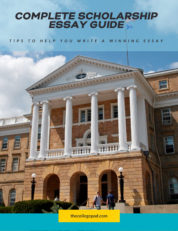Picture this: you’ve received your acceptance letter from your dream college, but the looming tuition fees seem insurmountable. This is a common scenario for many students and their families each year. However, there’s a beacon of hope: the types of financial aid available can make college more affordable.
Contrary to popular belief, the types of financial aid are not as elusive or complex to apply for as they may seem. In fact, they can significantly alleviate the financial strain of college, making college more accessible and affordable for everyone.
In this blog post, we’ll shed light on the types of financial aid, breaking down the various forms available - from grants and scholarships to work-study programs and loans. With a clear understanding of these options, you can make informed decisions about financing your education. So, let’s embark on this journey to explore how the types of financial aid can make college more affordable.
What is financial aid?
Financial aid is money that helps students pay for college. It can come from different places, like the federal government, state governments, colleges, private groups, or employers. Financial aid is typically awarded based on merit or financial need, although some might be awarded based on organization affiliation (e.g., Michigan's Children of Veterans Tuition Grant).
There are four main types of financial aid available: grants, scholarships, loans, or work-study programs.
Grants and Scholarships: Grants and scholarships are financial aid that you don't have to pay back. They are usually based on how much money you need, how well you do in school, or other things. Some examples are the Pell Grant, FSEOG, TEACH Grant, state grants, college grants, and private scholarships.
Loans: Loans are financial aid that you have to pay back with interest. They can come from the federal government or private lenders. Some examples of federal loans are the Direct Subsidized Loan, the Direct Unsubsidized Loan, the Direct PLUS Loan, and the Direct Consolidation Loan. Banks, credit unions, or other financial groups offer private loans. They usually have higher interest rates and less benefits than federal loans.
Work-study programs: Work-study programs are financial aid that let students earn money by working part-time on or off campus. They are usually based on how much money you need and how much money is available. Work-study programs can help students get valuable work skills and use less loans.
>>RELATED POST: 16 Financial Aid Terms You Should Know
How to apply for financial aid?
The first step to apply for most types of financial aid is to fill out the FAFSA (Free Application for Federal Student Aid). The FAFSA online application collects information about your family's income, assets, and household size. Your information will help determine your eligibility for federal grants, loans, and work-study programs. The same information may also determine your eligibility for the college's money awarded through scholarships and grants.
You can submit the FAFSA as early as October 1 of the year before your child plans to attend college. The deadline varies by state and college. However, some financial aid is awarded on a first-come, first-served basis, so the earlier you apply the better your chances.
Some colleges may also require you to fill out additional forms or applications to apply for their types of financial aid. For example, some colleges (mostly private ones) may require you to submit the CSS Profile. The CSS Profile is a more detailed financial aid application form that collects information about your family's finances.
Then there are outside or private scholarships. These tend to come from corporations, foundation, civic groups and other organizations. The application process, eligibility, and requirement varies. Some scholarships only require an application, while others need additional documents like an essay, recommendations, and transcript. Use a scholarship search engine to find private scholarships.
>>RELATED POST: 5 Reasons You Should Borrow Less for College
How to find the best types of financial aid for your child?
There is no one-size-fits-all answer to this question.
The optimal financial aid for your child hinges on your finances, their academic results, career aspirations, and personal choices. However, here are some general tips that can help you find the best types of financial aid for your child:
- Apply for all types of financial aid that you are eligible for. You never know what you may qualify for unless you apply. Even if you think you make too much money or have too many assets, you may still be eligible for some types of financial aid. And federal and private student loans are available to families with or without financial need.
- Compare different types of financial aid offers from different colleges. Each college may offer your child different amounts and types of financial aid based on their policies and resources. You should compare the net cost of attending each college after subtracting the total amount of grants and scholarships from the total cost of attendance. The net cost is what you and your child will have to pay out-of-pocket or borrow through loans.
- Look for scholarships that match your child's interests and abilities. Millions of scholarships are available from various sources that cater to different groups of students based on their academic achievements, extracurricular activities, community service, hobbies, talents, or backgrounds. You can use online databases or search engines to find scholarships that suit your child's profile.
- Consider the pros and cons of loans. Loans can help you cover the gap between the cost of attendance and the amount of grants and scholarships. However, they also have some drawbacks. Loans have to be repaid with interest over time, which can add to a significant debt burden after graduation.
- 17 Colleges That Give The Most Financial Aid
- Should I Go To Community College First
- Understanding Merit Aid: Your Guide to Financial Aid Success
How to go to college for free?
Believe it or not, some financial aid packages can make college completely free or much more affordable. While going to college for free may sound too good to be true, it is possible for some students. There are several ways to make college more affordable, such as:
- Attending a tuition-free college. Some colleges have no tuition but may have other fees or requirements. For instance, students may need to work on campus, serve in the military, or meet academic standards. Examples of tuition-free colleges include Berea College, College of the Ozarks, Alice Lloyd College, and Curtis Institute of Music. Public universities like the University of Michigan (Go Blue Guarantee) also offer tuition-free programs for low-income students.
- Attending a community college. Some states provide free or reduced tuition for residents at community colleges. For instance, Tennessee Promise offers eligible high school graduates two years of tuition-free community college. New York Excelsior Scholarship covers tuition at public colleges for qualified residents. Similar programs exist in California, Oregon, Rhode Island, Maryland, and Delaware. Additionally, depending on career goals, an associate degree may be sufficient.
- Applying for full-ride scholarships. Some scholarships cover the full cost of attendance at a college, including tuition, fees, room and board, books, and other expenses. These scholarships are usually very competitive and require exceptional academic performance, leadership skills, or community involvement. Some examples of full-ride scholarships are the Gates Scholarship, the Coca-Cola Scholars Program, and the Jack Kent Cooke Foundation Scholarship Program.
- Applying to the right college. A free college education is possible if you apply to generous colleges or the military academies. Generous colleges have large endowments and meet 100% of your financial need, but they are often very selective and competitive. Military academies train you for the armed forces and cover all your expenses, but you must serve in the military after graduation. You need excellent grades and activities to get in, and you need to research their requirements and expectations before applying.
>>RELATED POST: 12 Small Tuition-Free Colleges
Conclusion
Paying for college can be a daunting task for many parents and students. However, understanding what types of financial aid are available and how to apply for them can make the process easier and more affordable.
Remember to apply for all types of financial aid that you are eligible for, compare different types of financial aid offers from different colleges, look for scholarships that match your child's interests and abilities, consider the pros and cons of loans and work-study programs, and explore the possibilities of going to college for free.
By doing so, you can find the best types of financial aid for your child and help them avoid student loans like the plague.



